Keywords
|
| Impulse, Median filter, PSNR, salt & pepper |
INTRODUCTION
|
| Salt & pepper noise is a type of impulse noise which is typically observed in images. It represents itself as randomly occurring white and black pixels. An image containing this type of noise will have dark pixels in bright regions and bright pixels in dark regions. This type of noise can be caused by dead pixels, analog-to-digital converter errors, bit errors in transmission, etc. |
| In past years, linear filters became the most popular filters in image signal processing. The reason of their popularity is caused by the existence of robust mathematical models which can be used for their analysis and design. However, there exist many areas in which the nonlinear filters provide significantly better results. The advantage of nonlinear filters lies in their ability to preserve edges and suppress the noise without loss of details. The success of nonlinear filters is caused by the fact that image signals as well as existing noise types are usually nonlinear. As salt and pepper noise is a random valued shot noise, it is very difficult to remove this type of noise using linear filters because they tend to smudge resulting images. |
| Traditionally, the impulse noise is removed by a median filter which is the most popular nonlinear filter. However, the standard median filter[1] gives a poor performance for images corrupted by impulse noise with higher intensity. A simple median filter utilizing 3×3 or 5×5-pixel window is sufficient only when the noise intensity is less than approx. 10-20%. When the intensity of noise is increasing, a simple median filter remains many shots unfiltered. Adaptive Median Filter (AMF) [2] perform well at low noise densities. But at high noise densities the window size has to be increased which may lead to blurring the image. In switching median filter [3], [4] the decision is based on a pre-defined threshold value. The major drawback of this method is that defining a robust decision is difficult. Also these filters will not take into account the local features as a result of which details and edges may not be recovered satisfactorily, especially when the noise level is high. To overcome this drawback, a decision based algorithm is proposed. In this, image is denoised by using a 3×3 window. If the processing pixel value is 0 or 255 it is processed or else it is left unchanged. The selected 3× 3 window elements are arranged in either increasing or decreasing order. Then the pixel values 0’s and 255’s in the image (i.e., the pixel values responsible for the salt and pepper noise) are removed from the image. Then the median value of the remaining pixels is taken. This median value is used to replace the noisy pixel. |
IMPULSE NOISE MODEL
|
| The Salt and Pepper (SP) noise is also called as fixed valued impulse noise will take a gray level value either minimal (0) or maximal (255) (for 8-bit monochrome image) in the dynamic range (0-255) [12] [20] [21]. It is generated with the equal probability. In the case of salt and pepper noise, the image pixels are randomly corrupted by either 0 or 255. Consider an image I and an observation image X of same size |
 |
| Where i=1,2,…..s1 and j=1,2,…..s2 and 0<p<1. Iij and Nij denotes the pixel values at location (i,j) of the original image and the noisy image, respectively and Nij a noise value independent from Iij.For gray level images with 8 bits per pixel ,when the images are contaminated by fixed value impulse noise, Nij the corrupted pixel is equal to 0 or 255 each with equal probability (p/2). |
PROPOSED ALGORITHM
|
| The proposed Decision Based Median Filter algorithm processes the corrupted images by first detecting the impulse noise. The processing pixel is checked whether it is noisy or noisy free. That is, if the processing pixel lies between maximum and minimum gray level values then it is noise free pixel, it is left unchanged. If the processing pixel takes the maximum or minimum gray level then it is noisy pixel which is processed by proposed algorithm. |
| A. Algorithm |
| Step 1: Select 2-D window of size 3× 3. Assume that the pixel being processed is Pij |
| Step 2: If centre pixel 0<P ij <255 then P ij value is left unchanged. |
| Step 3: If P ij =0 or P ij =255then check for next condition |
| Step 4: If processing pixel is 0 or 255 & also surrounding all elements has same value then processing element is an information instead of noise as there is high co-relation between neighboring pixels so pixel value should keep as it was. Otherwise check for next condition. |
| Step 5: P ij is a corrupted pixel then two cases are possible as given in Case i) and ii). |
| Case i): If the selected window contain all the elements as 0’s and 255’s. Then replace P ij. with the mean of the element of window. |
| Case ii): If the selected window contains not all elements as 0’s and 255’s. Then eliminate 255’s and 0’s and find the median value of the remaining elements. Replace P ij. with the median value. |
| Step 6: Repeat steps 1 to 5 until all the pixels in the entire image are processed. |
| B. Illustration of Algorithm |
| Each and every pixel of the image is checked for the presence of salt and pepper noise. Different cases are illustrated in this Section. If the processing pixel is noisy and all other pixel values are either 0’s or 255’s is illustrated in Case i). If the processing pixel is noisy pixel that is 0 or 255 is illustrated in Case ii). |
| Case i): If the selected window contains salt/pepper noise as processing pixel (i.e., 255/0 pixel value) and neighboring pixel values contains all pixels that adds salt and pepper noise to the image: |
| where “255” is processing pixel, i.e., P ij Since all the elements surrounding are 0’s and 255’s.If one takes the median value it will be either 0 or 255 which is again noisy. To solve this problem, the mean of the selected window is found and the processing pixel is replaced by the mean value. Here the mean value is 142. Replace the processing pixel by 142. |
| Case ii): If the selected window contains salt or pepper noise as processing pixel (i.e., 255/0 pixel value) and neighboring pixel values contains some pixels that adds salt (i.e., 255 pixel value) and pepper noise to the image: |
| Now eliminate the salt and pepper noise from the selected window. That is, elimination of 0’s and 255’s. The 1-D array of the above matrix is [78 90 0 120 0 255 97 255 73]. After elimination of 0’s and 255’s the pixel values in the selected window will be [78 90 120 97 73]. Here the median value is 90. Hence replace P ij the processing pixel by 90. |
| Fig3 shows filter processing flow |
EXPERIMENTAL RESULTS
|
| The proposed algorithm is tested using 60X125, 8-bits/pixel standard images such as Cameraman, Rice & Eight. The performance of the this algorithm is tested for various levels of noise corruption. Each time the test image is corrupted by salt and pepper noise of different density ranging from 10 to 90 with an increment of 10 will be applied to the filter. In addition to the visual quality, the performance of the proposed algorithm is quantitatively measured by the following parameters such as peak signal-to-noise ratio (PSNR) & Mean square error(MSE). |
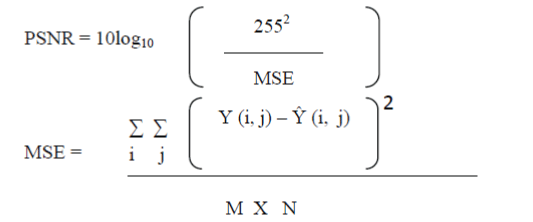 |
| where MSE stands for mean square error, Y represents the original image, Ãâ¦Ã¶ denotes the denoised image and M x N is the size of the image. Filter is implemented in MATLAB 7.1 and filtering window used for experiments is of size 3x3. |
CONCLUSION
|
| A new algorithm is proposed which gives better performance in terms of PSNR. The performance of the algorithm has been tested at low, medium and high noise densities on gray-scale images. Even at high noise density levels the algorithm gives better results in comparison with other existing algorithms. Both visual and quantitative results are demonstrated. The proposed algorithm is effective for salt and pepper noise removal in images at high noise densities. |
Tables at a glance
|
 |
| Table 1 |
|
Figures at a glance
|
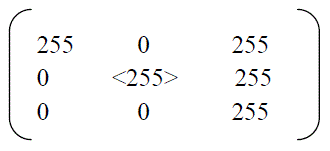 |
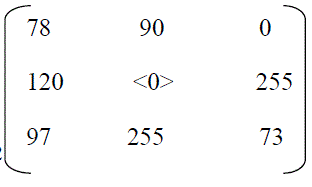 |
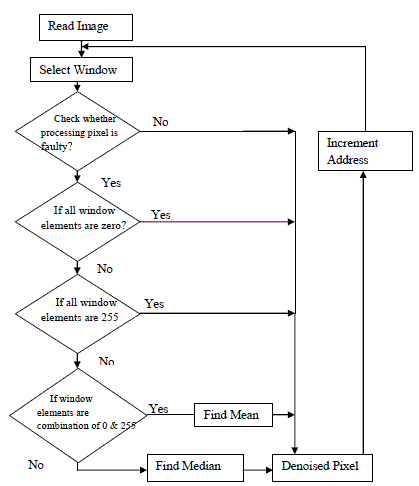 |
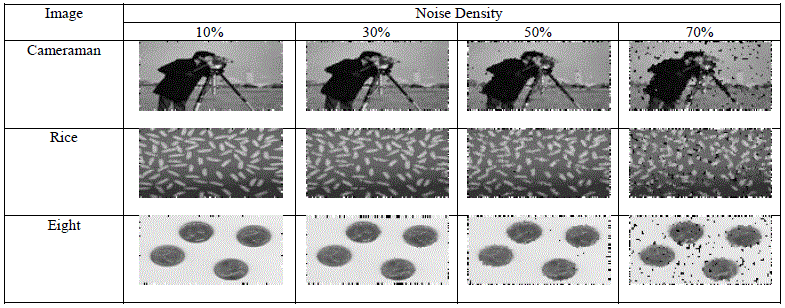 |
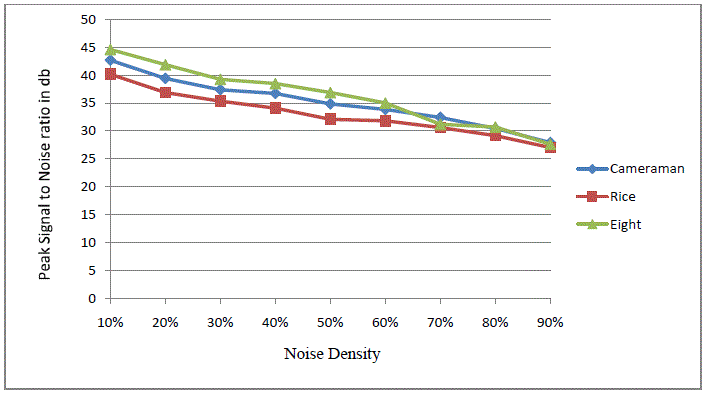 |
| Figure 1 |
Figure 2 |
Figure 3 |
Figure 4 |
Figure 5 |
|
References
|
- DagguVenkateshwarRao, ShrutiPatil, Naveen Anne Babu and V Muthukumar “Implementation and Evaluation of Image Processing Algorithms onReconfigurable Architecture using C-based Hardware Descriptive Languages” International Journal of Theoretical and Applied Computer SciencesVolume 1 Number 1 (2006) pp. 9–34
- H. Hwang and R. A. Hadded, “Adaptive median filter: New algorithms and results,” IEEE Trans. Image Process., vol. 4, no. 4, pp. 499–502, Apr.1995.
- S. Zhang and M. A. Karim, “A new impulse detector for switching median filters,” IEEE Signal Process. Lett., vol. 9, no. 11, pp. 360–363, Nov. 2002.
- P. E. Ng and K. K. Ma, “A switching median filter with boundary discriminative noise detection for extremely corrupted images,” IEEE Trans. ImageProcess., vol. 15, no. 6, pp. 1506–1516, Jun. 2006.
- W. Zhou and Z. David, “Progressive switching median filter for the removal of impulse noise from highly corrupted images,” IEEE Trans On Circuitsand Systems: Analog and Digital Signal Processing, vol. 46, no. 1, pp. 78–80, 1999.
- D. R. K. Brownrigg, “The weighted median filter,” Commun. ACM, vol. 27, no. 8, pp. 807–818, 1984.
- S. Marshall, “New direct design method for weighted order statistic filters,” VISP, vol. 151, no. 1, pp. 1–8, February 2004.
|